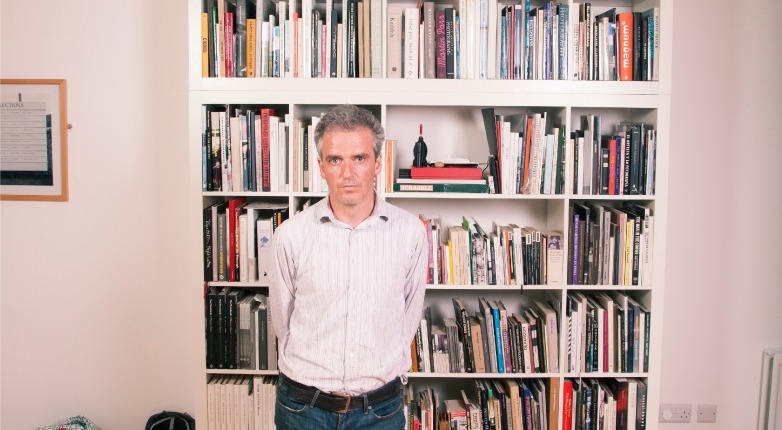Donovan Wylie’s interest in buildings was fueled by a fascination with function. Surveillance was ubiquitous during the Troubles, the decades of violent clashes between sects of Northern Ireland’s Irish Catholic nationalist and British Protestant unionist communities. Wylie, who experienced this firsthand while growing up in Belfast, became curious about the physical structures of surveillance, the ubiquitous watchtowers and fortifications built to protect citizens. Such architecture, despite its strange sculptural beauty, sends a rather brutal and invasive message. These constructions embody a basic notion that to this day fascinates the 43-year-old Magnum photographer: the unequivocally primitive idea of taking a high ground from which to watch and survey.
North Warning System, Wylie’s latest book, is the third and final installment of his Tower series published by Steidl, which meticulously documents watchtowers in three different historical-political settings (and incidentally, three distinct color palettes). In British Watchtowers (2008), Wylie focused on England’s surveillance stations along the border with Northern Ireland, and the verdant landscapes they guarded; for Outposts (2011), he photographed NATO observation posts in Afghanistan’s Kandahar province. In the latter book, the often rough-hewn structures sit on high ground in midst of their earth-and-sand topography, and come perilously alive with the knowledge that the project was made during years of active conflict. The third in the series documents a single watchtower of the North Warning System (NWS), a joint U.S.-Canada radar network put in place in the late ’80s that guards the northern borders from long-range missiles and maritime threats—as did its predecessor, the Cold War–era radar system known as Distant Early Warning Line
Wylie developed the Tower series after working on The Maze—first published in 2004 by Granta and later by Steidl in a two-volume edition—his first foray into a typological record of architecture. For The Maze, he began photographing Belfast’s Maze prison as it was being decommissioned and the last prisoners left; the infamous detention center had held paramilitary prisoners from both nationalist and unionist factions, and had been the site of the 1981 hunger strikes. The project allowed Wylie to reengage with photography after a personal hiatus from the medium, and to grapple with an ominous architectural emblem of his country’s past; he also felt great pressure to deliver on such a historically charged assignment.
The duty involved in, and importance of, taking pictures has never been lost on Wylie: He picked up a camera at age 11 and spent the first two years photographing without film. It was when people asked to see the pictures that the young photographer grew nervous. “It was an absolute nightmare … the moment I put film in the camera I had to think differently,” he says. “Making pictures came with great responsibility.” Wylie says he still feels this way, despite many decades of experience.
After 90-odd days working at the Maze, Wylie says he finally arrived at a visual solution—a detached, typological approach that he later employed in the Tower series. “I understood that the system of the architecture has to control me,” he says. “Therefore I have to respond to its system, I have to photograph it accordingly to its logic.”
His perspective on the watchtowers—which Wylie describes as the “Bechers’ approach from a helicopter,” referencing the conceptual work of German duo Bernd and Hilla Becher—is clinical and unmoored, and mostly uniform across the series: landscape-format compositions with the observation posts at the center, interspersed with views from the high seat. “I tried to look at the tower in exactly the way that it would look at itself,” he says.
With North Warning System, Wylie took this approach into its purest form: all of the photographs in the book are of the tower, and with each turning of the page, the photographer brings viewers closer to the structure, revealing a shifted perspective and vantage point of it. The experience is one of ethereal travel, as if he’s taking viewers into the helicopter with him for a slow approach. The landscape is stark and white, laced with hues of silver grey, icy blues, and the charcoal rock face of the mount on which the tower perches.
Wylie’s strategy was mostly metaphorical. “I wasn’t trying to make a survey,” he says. “For me, what was interesting was the idea of an automated machine looking at something that’s not there, or maybe, will be there …” While the NWS structures are now many decades old, the photographs transmit a mood both futuristic and anachronistic—perhaps a better term would be “timeless.” These constructions are lone bastions of automated vision standing in midst of a seemingly infinite white landscape.
For Wylie, it was a fitting final chapter for the Tower trilogy. The loneliness of the NWS tower pressed home the fundamentally human idea that underlies all three projects but extends into a much deeper meaning. As he puts it, “The idea of isolation, of wanting to make a home and protecting it—that goes to the core of who we are.”
